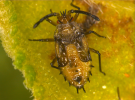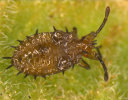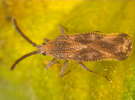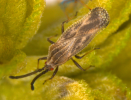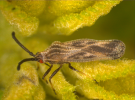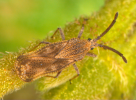 |
Scientific nameTeleonemia scrupulosa Stål
Common nameLantana lace bug
Taxonomic positionHemiptera: Heteroptera: Tingidae
DiagnosisAdult: Length 3-4 mm; width 1.1-1.3 mm. Body outline elongate oval, appearing widest / expanded near middle and apically bluntly rounted. Dorsal side brownish; fore wings with an obscure dark brown "X" pattern formed by the veins, usually flanked by a pair of variably shaped brown spots on the swollen middle area of each wing; cells on costal / outer margin of wings more or less rectangular / quadrate; discoidal area finely pubescent. Antennae 4-segmented, cylindrical, segments 1 and 2 subequal, third nearly twice as long as the other three segments combined, segment 4 spindle-shaped. Pronotum with three prominent longitudinal ridges.
Nymphs: Dull to darkish brown, head with three vertical spines / projections between antennal insertions and a pair of laterally projecting spines below eyes; lateral sides of abdomen bear a series of prominent spines. The wing pads become prominent in the later instars. Adult bugs and nymphs are found usually on the ventral surface of young leaves. The infested leaves show typical dark brown to black, scorched or burnt areas caused due to the feeding of the bugs. ImagesDistributionTeleonemia scrupulosa is a native of the Americas and ranges naturally from Florida and Texas southward through Mexico and Central America to southern Brazil, Paraguay, and northern Chile. It was intentionally introduced into Fiji, Australia, New Caledonia, Norfolk Island, Java, India, Kenya, Tanzania, Uganda, South Africa, Central African Republic, Zambia, Mauritius, and many Pacific and Indian Ocean islands (Harley & Kassulke, 1971).
It was introduced in India from Australia in 1941, but not released in the field as the adults fed on teak flowers in quarantine (Roonwal, 1952). The culture was supposed to have been destroyed, but the bug escaped quarantine and now it is recorded on lantana throughout India (Karnataka; Kerala; Tamil Nadu; Uttar Pradesh; Uttaranchal; northeastern region). Introduced in several other countries such as Australia and USA. Hosts / BiologyHarley and Kassulke (1971) recorded about 15 species of plants (mostly Lantana and Leucophyllum spp.) as hosts of T. scrupulosa. However, damage to plants other than lantana
has been slight and transitory with one exception. In East Africa after defoliating lantana, lantana lace bugs moved to sesame (Sesamum indicum L.) causing economic losses to the crop (Greathead 1968).
It is the most common natural enemy of Lantana camara in India. The bug feeds on the undersurface of the leaves and attacks newly opened buds and flowers. It causes defoliation and restricts the growth of lantana, but has limited efficacy as the weed is not killed outright (Singh, 1976; Bisht and Bhatnagar, 1978). The female starts laying eggs on the underside of tender leaves a day after emergence. About 48-60 eggs are laid during the life span of 15-35 days. The eggs hatch in 4-6 days and 4-5 nymphal instars are completed in 12-22 days (Varma and Sadatullah, 1974). The field efficacy of T. scrupulosa is further reduced by an egg parasitoid, Erythmelus teleonemiae (Subba Rao) (=Parallelaptera teleonemiae Subba Rao) (Hymenoptera: Mymaridae), an egg parasitoid of tingid bugs, parasitises as much as 85% of the eggs of T. scrupulosa, reducing its performance in the field (Singh, 1994). References
|
